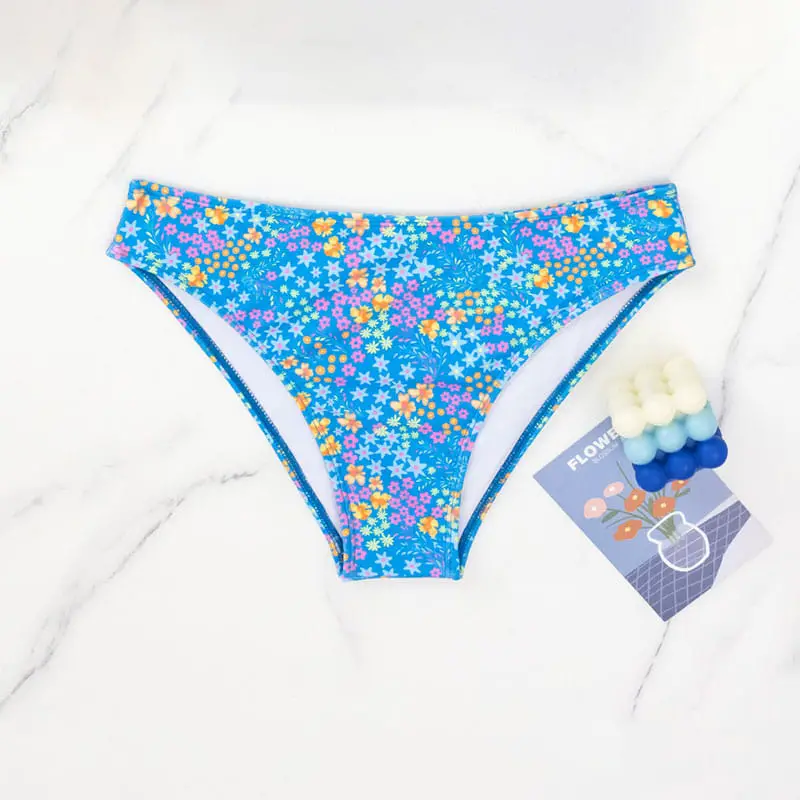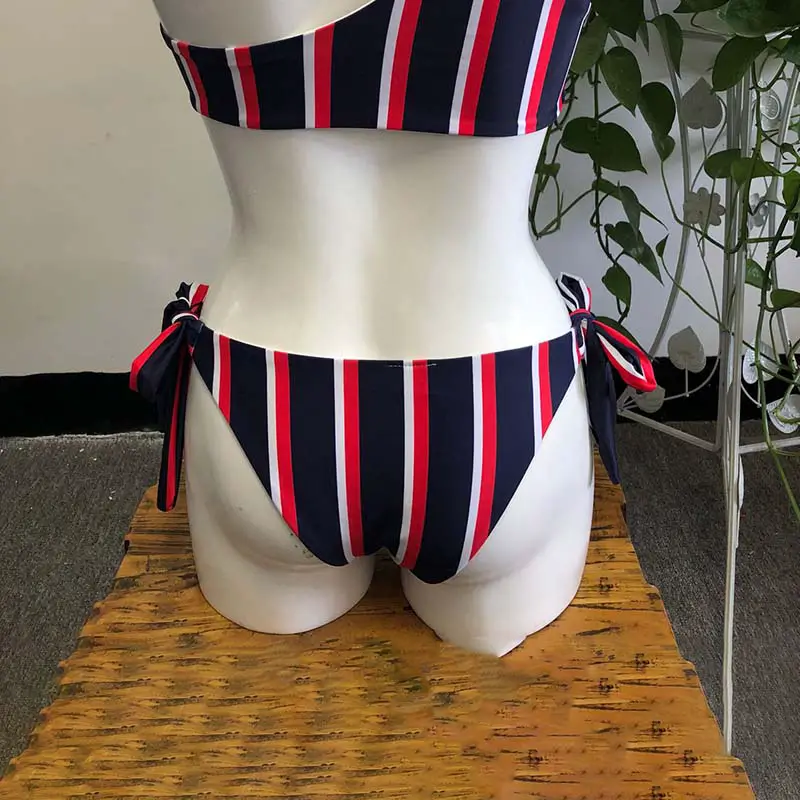How to tell if your bikini bottom is too small

The easiest way is to do a quick fit check. Stand in front of a mirror and check for the following:
- Do you see red marks or indentation from the waistband on your hips?
- When you look over your shoulder, does your bottom provide full coverage in back?
- After walking around, have you needed to pick a wedgie out of your bottoms?
- Can you comfortably squat or stretch without feeling restricted?
- Do you feel pinching, tightness, or chafing anywhere in the fabric?
- Do you feel self-conscious rather than confident wearing the bottoms?
If the answer is yes to any of these specific checks, your bikini bottom likely needs to go up a size. Read on for more details on signs your bottoms are too small and what to do about it.
7 signs your bikini bottom is too small
Bikini bottoms should never pinch, pull, or restrict your movement. Nor should you have to constantly adjust them to maintain coverage.

Listen to your body and what the suit is telling you. If you experience any of the signs below, it’s likely time to size up or make adjustments for a better fit.
The waistband digs into hips
One of the most obvious things of a bikini bottom being too small is if you can see and feel it digging into the skin on your hips.
The waistband should rest comfortably on your hips without biting in. If it leaves red marks or imprints on your skin, it’s time to size up.
Bottoms that are too tight will only become more uncomfortable when wet.
Bottom exposed in back
A bikini bottom that is too tiny will not provide ample coverage, especially in the back. You shouldn’t have to keep pulling at the fabric or readjusting to avoid revealing too much.
Check that your bottom fully covers your rear when standing and walking. Make sure you don’t see any cheek peeking out!
Your bikini bottom causes wedgies
Monitor if your bikini bottom creeps up and gives you a wedgie, especially after physical activity.
Wedgies are a nuisance and signal the back coverage is too small. You want bottoms that stay put where they should be.
The friction from your bottoms creeping up can lead to chafing and skin irritation around your bikini line region. If you are getting wedgies even when standing still, that is a definite sign the back coverage is too small.
It restricts movement
The right bikini bottom should move with your body and allow free range of motion. If yours restricts movement or feels like it might rip when you bend and stretch, it definitely doesn’t fit properly.
You shouldn’t have to hold your breath or move gingerly to avoid your bottoms malfunctioning.
It feels too tight
This may seem obvious, but anothe indication of small bikini bottoms is if they simply feel too tight all over.
The fabric should not be digging into your skin or pinching anywhere. You should feel secure but not squeezed into your bottoms. If they feel constricting or like a constant wedgie, it’s too small.
It causes irritation
When bikini bottoms are too tight, often the inner thigh and bikini line area will become red and irritated from the friction.
This can lead to painful chafing. The fabric shouldn’t be rubbing you raw – this usually means it needs more stretch.
What happens if your bikini bottom is too small
Discomfort and restricted movement
The tight, pinching fabric can dig into your hips, cause wedgies, and irritate your skin. You may find it difficult to move around freely and do activities like swimming, beach sports, or even just walking and sitting.
Specific activities like swimming laps, doing yoga stretches on the beach, and playing vigorous games may be hampered by bottoms that ride up or limit your mobility.
The discomfort can make you pick at the swimsuit constantly and detract from enjoying yourself.
Risk of unwanted exposure
Wearing bikini bottoms that are smaller put you at higher risk of malfunctioning and exposing areas you want to keep covered. W
hether it’s sudden exposure when moving quickly or gradual creeping of fabric, you will likely have to keep adjusting the swimsuit.
You may experience your bottoms creeping up into a wedgie or exposing your rear, unexpected untying, or splits along seams from being stretched too thin. This can lead to embarrassing moments.
Skin irritation and chafing
Along with general discomfort, bottoms that are too tight can cause skin redness, irritation, and painful chafing around the inner thighs, bikini line, and any area where the fabric rubs frequently. This can lead to rawness, blisters, and discomfort long after taking the swimsuit off.
Permanent stretching or damage
If a bikini bottom is drastically undersized, wearing it could lead to permanent stretching of the fabric or even tearing seams.
It could ruin the swimsuit permanently after just one wear. Forcing fabric to stretch excessively to fit your body can damage the elastic and materials.
What to do if your bikini bottom is too small
There are some quick DIY tricks you can try to make an undersized bikini bottom work, without having to whip out the sewing machine.
Loosen adjustable ties
If your bikini bottoms have adjustable ties at the hips or sides, loosen them to create a little more breathing room.
Just be careful not to go too loose or it may compromise coverage in the back. The tie knots should sit comfortably on your hips without digging in.
You can also re-tie the back ties to sit higher or lower for more or less rear coverage.
Remove any liner or padding
Many bikini bottoms include removable liner or padding around the front for extra coverage.
Ditching this extra inner layer can help eliminate some bulk and tightness, especially if the pads are sewn into the side straps.
Just make sure you still feel comfortable with the coverage after removing them.
Tuck in areas prone to wedgies
If you find your bikini bottoms creeping up into annoying wedgies, try tucking the fabric into the crease of your cheeks horizontally to keep it in place.
You can also place a small piece of fabric, tissue, or part of the liner padding under the side ties to help reduce pressure and pull on those cheeky areas.
Apply lubricant to reduce chafing
Too-tight bikini bottoms tend to cause chafing and irritation where fabric rubs frequently, like the inner thighs and bikini line.
Apply Vaseline to those areas before donning your suit to help minimize friction. Reapply after getting wet to keep the lubricant barrier.
And just try to avoid getting globs of jelly on the fabric.
Use tapes and bandages strategically
If your bikini is prone to shifting around too much, use nude-colored tape or bandages to securely hold sections in place.
Tape the ties at the hips so they don’t come undone as easily. Place bandages over any irritated areas like the bikini line to protect the skin and prevent worse chafing.
Add coverage with accessories
Wearing swim shorts or a swim skirt as a swimsuit cover-up can help compensate for bikini bottoms offering less coverage than desired.
Look for athletic shorts made of quick-dry material. Or have a sarong wrap over your bikini to add a stylish layer of coverage and confidence.
Consider sewing alterations if handy
For those comfortable doing minor sewing adjustments, you can carefully let out the side seams of the bikini bottoms for a slightly looser fit.
Just be conservative so you don’t compromise the structure. Or add small fabric panels at the sides to increase coverage and create a more cheeky look from a skimpy thong.
Carefully take in the side seams about 1⁄4 to 1⁄2 inch for a slimmer fit through the hips and rear.
Be mindful not to go too narrow. You can also lower and enlarge the leg holes for more coverage and to prevent bottoms creeping up.
Cut small v-shapes around the leg holes and insert triangles of matching fabric to open them up.
Just be sure to re-stitch the edging cleanly. If the front coverage is too revealing, add narrow strips of fabric along the waistline to widen that area. Get creative with panels and extra fabric to customize the fit!
When all else fails, it may be time to replace
If you’ve tried all the quick tweaks but your bikini bottom still isn’t comfortable, it may be time to replace it with a new one better suited to your body.
There’s no shame in giving up or choosing a different style, like high-waisted bottoms or swim shorts. The goal is to feel relaxed, not constantly adjusting your suit!
With some clever adjustments, you can often stretch a too-small bikini bottom to work in a pinch. But if it’s still restricting your enjoyment, invest in a new bottom that makes you feel fabulous.
